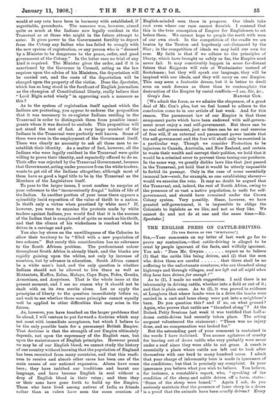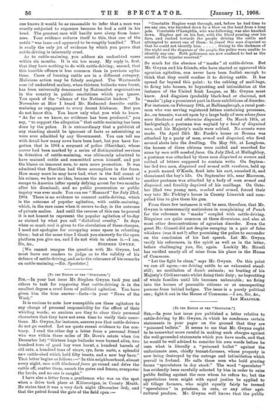THE ENGLISH PRESS ON CATTLE-DRIVING.
MO THE EDITOR OF THE "SPEOTA.T011.".1
Sin,—Your comments on my letter of last week go far to prove my contention,—that cattle-driving is alleged to be cruel by people ignorant of the facts, and wilfully ignorant.
You ask : "Does Mr. Gwynn expect us to believe (1) that the cattle like being driven, and (2) that the men be no who drive them are careful that there shall
suffering to the unfortunate creatures, who are thrashed along highways and through villages, and are left out all night when they have been. driven far enough ?"
As to (1). I made no such suggestion. I said there is no inhumanity in driving cattle, whether into a field or out of it ; and that is plain sense. As to (2), it was proved in evidence at Loughrea that where lambs were in a drive the lambs were carried in a cart and lame sheep were put into a neighbour's barn. Do you question this and if so, on what ground ? Again, who proves that cattle are "thrashed along " ? At the Duleek Petty Sessions last week it was testified that half-a- dozen cattle-drives had recently taken place. The acting sergeant volunteered the statement: "There was no injury done, and no compensation was looked for."
But the astounding part of your comment is contained in the words I have italicised. You accuse agitators of cruelty for leaving out of doors cattle who very probably were never under a roof since they were able to eat grass. A ranch is essentially a place where cattle are left out to look after themselves with one herd to many hundred acres. I admit that your charge of inhumanity here is made in ignorance of the conditions; but that is precisely my complaint. In your ignorance you believe what you wish to believe. You believe, for instance, a constable's report, who, "speaking of the condition of the sheep and cattle driven off a farm, states : 'Some of the sheep were lamed." Again I ask, do you seriously maintain that the presence of lame sheep in a drove is a proof that the animals have been cruelly driven ? Every one knows it would be as reasonable to infer that a man was cruelly subjected to exposure because be had a cold in his head. The greatest care will hardly save sheep from lame- ness. • Your evidence reduces itself to this, that one of the cattle "was Lame and appeared to be roughly handled." That is really the only jot of evidence by which you prove that cattle-driving is inherently cruel.
As to cattle-maiming, you adduce six undoubted cases within six months. It is six too many. My reply is, first, that they have nothing to do with cattle-driving; second, that this horrible offence is less common than in previous agita- tions. Cases of burning cattle are in a different category. Malicious action may be falsely assigned. The Westmeath case (of undoubted malice), when thirteen bullocks were burnt, has been universally denounced by Nationalist organisations in the country in public resolutions which you ignore. You speak of the "silence of the Nationalist leaders." In November at Birr I heard Mr. Redmond describe cattle- maiming as repugnant to every decent Irishman. But you do not know this. You know only what you wish to know. "As far as we know, no evidence has been produced," you say, "to support the allegation" that cattle-maiming has been done by the police. It is extraordinary that a publicist of any standing should be ignorant of facts as astonishing as were ever admitted by any Government. You can tell me with detail how many cows have been hurt, but you have for- gotten that in 1904 a sergeant of police (Sheridan), whose career had been marked by a series of distinguished services in detection of cattle-maiming, was ultimately admitted to have maimed cattle and committed arson himself, and put the blame on innocent men, to earn more promotion. It was admitted that Sheridan had three accomplices in the force. How many more he may have had, what is the full count of his crimes, we have no idea, because the man was allowed to escape to America (after openly defying arrest for two months after his dismissal), and no public prosecution or public inquiry was ever made. You can see "Hansard" for July 23rd, 1904. There is no evidence to connect cattle-driving, which is the outcome of popular agitation, with cattle-maiming, which, in the rare cases when it occurs to-day, is the outcome of private malice. And until the reverse of this can be proved it is not honest to represent the popular agitation of to-day as stained by what you call "diabolical cruelty." In days when so much zeal is given to the circulation of these charges, I need not apologise for occupying some space in rebutting them; but at the same time I thank you sincerely for the open
platform you give me, and I do not wish to abuse am, [We cannot reargue the question with Mr. Gwynn, but must leave our readers to judge as to the validity of his defence of cattle-driving, and as to the relevance of his remarks on cattle-maiming.—En. Spectator.1











































 Previous page
Previous page